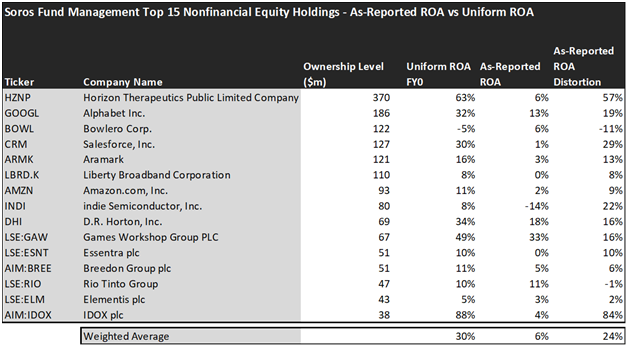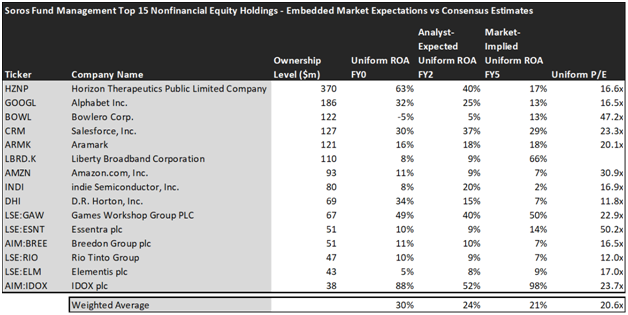In September 2021, Soros avoided Chinese stocks despite their surge in investment due to increased US-China trade. Recent events, including numerous Chinese companies defaulting on their debts and plummeting stocks, have proven Soros’s decision to be right. In today’s FA Alpha Daily, let’s examine Soros’s portfolio and his largest current holdings using Uniform Accounting to see how he positioned himself for the future.
FA Alpha Daily:
Friday Portfolio Analysis
Powered by Valens Research
In 2021, George Soros made a controversial call. Everyone else was zeroing in on Chinese stocks. Blackrock was making major investments in the country.
Everyone thought that the pandemic was behind us, China was rising, and it was an awesome time to jump into the company.
Soros though saw something quite different. He thought it was wise to stay far away from Chinese stocks.
China didn’t seem to have a booming economy and market when he looked at it. As Xi Jinping consolidates power, he sees an increase in political risk for Chinese companies. He saw the increased geopolitical risk that could disrupt markets. He also saw concerns about economic growth.
Lo and behold, Xi Jinping managed to stay in power for a third term, and things have only started looking worse.
Since then, Shanghai Stock Exchange Composite Index (SSE Index) has lost around 10%, the largest Chinese property developer Evergrande has defaulted, and the real estate crisis has gone deeper.
Big Chinese names like Alibaba (BABA) and Tencent (700:HKG) have just kept sinking since he warned that the political environment could get in the way of innovation.
It looks like all his concerns have been proven out.
His 65+ years of experience and his “reflexivity” framework help him to identify concerning situations like this in global markets.
This framework suggests that an individual’s beliefs can influence the state of the world, and vice versa, creating feedback loops.
Soros uses this framework to explain how financial markets can be influenced by the beliefs of market participants, creating self-reinforcing cycles of boom and bust.
His belief in this framework is what fueled his confidence in his famous trade to break the Bank of England in 1992, where he bet against the British Pound believing it was overvalued.
Now with the rising importance of macro trends like nearshoring and onshoring, it appears Soros has positioned himself to avoid disruptions from markets like China.
Looking closer at his portfolio using the Uniform Accounting framework, we can see if he just got this idea right, or if he’s identifying broader signals that create upside potential.
Economic productivity is massively misunderstood on Wall Street. This is reflected by the 130+ distortions in the Generally Accepted Accounting Principles (GAAP) that make as-reported results poor representations of real economic productivity.
These distortions include the poor capitalization of R&D, the use of goodwill and intangibles to inflate a company’s asset base, a poor understanding of one-off expense line items, as well as flawed acquisition accounting.
It’s no surprise that once many of these distortions are accounted for, it becomes apparent which companies are in real robust profitability and which may not be as strong of an investment.
See for yourself below.


Looking at as-reported accounting numbers, investors would think that George Soros was not right with his investments at all.
On an as-reported basis, many of the companies in the fund are poor performers. The average as-reported ROA for the top 15 holdings of the fund is 6%, which is significantly below the U.S. corporate average.
However, once we make Uniform Accounting adjustments to accurately calculate the earning power, we can see that the average return in Soros Fund Management’s top 15 holdings is actually 30%.
As the distortions from as-reported accounting are removed, we can see that Horizon Therapeutics (HZNP) isn’t a 6% return business. Its Uniform ROA is 63%.
Meanwhile, Salesforce (CRM) looks almost like an unprofitable company with only a 1% return, but this massive application software company actually powers a 30% Uniform ROA.
That being said, to find companies that can deliver alpha beyond the market, just finding companies where as-reported metrics misrepresent a company’s real profitability is insufficient.
To really generate alpha, any investor also needs to identify where the market is significantly undervaluing the company’s potential.
These dislocations demonstrate that most of these firms are in a different financial position than GAAP may make their books appear. But there is another crucial step in the search for alpha. Investors need to also find companies that are performing better than their valuations imply.
Valens has built a systematic process called Embedded Expectations Analysis to help investors get a sense of the future performance already baked into a company’s current stock price. Take a look:


This chart shows four interesting data points:
- The average Uniform ROA among Soros Fund Management’s top 15 holdings is actually 30% which is much better than the corporate average in the United States.
- The analyst-expected Uniform ROA represents what ROA is forecasted to do over the next two years. To get the ROA value, we take consensus Wall Street estimates and convert them to the Uniform Accounting framework.
- The market-implied Uniform ROA is what the market thinks Uniform ROA is going to be in the three years following the analyst expectations, which for most companies here are 2023, 2024, and 2025. Here, we show the sort of economic productivity a company needs to achieve to justify its current stock price.
- The Uniform P/E is our measure of how expensive a company is relative to its Uniform earnings. For reference, the average Uniform P/E across the investing universe is roughly 20x.
Embedded Expectations Analysis of Soros Fund Management paints a clear picture. Over the next few years, Wall Street analysts expect the companies in the fund to slightly decline in profitability. The market agrees with analysts but has an even more pessimistic view.
Analysts forecast the portfolio holdings on average to see Uniform ROA decline to 24% over the next two years. At current valuations, the market’s expectations are lower than analysts and it expects a 21% Uniform ROA for the companies in the portfolio.
For instance, Alphabet (GOOGL) returned 32% this year. Analysts think its returns will fall slightly to 25%. And at a 16.5x Uniform P/E, the market expects profitability to fall even further and is pricing Uniform ROA to be around 13%.
Similarly, Amazon’s (AMZN) Uniform ROA is 11%. Analysts expect its returns will drop to 9%, but the market is slightly more pessimistic and pricing its returns to be around 7%.
Overall, we can see that Soros has positioned himself primarily in the U.S. market with incremental exposure to industrial commodity businesses that will benefit from global investment.
The low expectations of the market for these names provide significant upside potential to his fund, just as you would expect from a legendary investor.
Of course, investors should be careful when making investment decisions and analyze the current valuations and the market’s expectations, and not just blindly follow any investor, including a great like George Soros.
This just goes to show the importance of valuation in the investing process. Finding a company with strong profitability and growth is only half of the process. The other, just as important part, is attaching reasonable valuations to the companies and understanding which have upside which has not been fully priced into their current prices.
To see a list of companies that have great performance and stability also at attractive valuations, the Valens Conviction Long Idea List is the place to look. The conviction list is powered by the Valens database, which offers access to full Uniform Accounting metrics for thousands of companies.
Click here to get access.
Read on to see a detailed tearsheet of one of Soros Fund Management’s largest holdings.
SUMMARY and Horizon Therapeutics Public Limited Company Tearsheet
As one of Soros Fund Management’s largest individual stock holdings, we’re highlighting Horizon Therapeutics Public Limited Company (HZNP:USA) tearsheet today.
As the Uniform Accounting tearsheet for Horizon Therapeutics Public Limited Company highlights, its Uniform P/E trades at 16.6x, which is around the global corporate average of 18.4x, and its historical average of 16.9x.
Average P/Es require average EPS growth to sustain them. In the case of Horizon Therapeutics Public Limited Company, the company has recently shown 65% Uniform EPS growth.
Wall Street analysts provide stock and valuation recommendations that, in general, provide very poor guidance or insight. However, Wall Street analysts’ near-term earnings forecasts tend to have relevant information.
We take Wall Street forecasts for GAAP earnings and convert them to Uniform earnings forecasts. When we do this, Horizon Therapeutics Public Limited Company’s Wall Street analyst-driven forecast is for EPS to grow by 5% and 23% in 2023 and 2024, respectively.
Furthermore, the company’s return on assets was 63% in 2022, which is 10x the long-run corporate averages. Also, cash flows and cash on hand consistently exceed its total obligations—including debt maturities and CAPEX maintenance. Moreover, its intrinsic credit risk is 30bps above the risk-free rate. Together, these signal low operating risks and low credit risks.
Lastly, Horizon Therapeutics Public Limited Company’s Uniform earnings growth is in line with peer averages, and in line with peer valuations.
Best regards,
Joel Litman & Rob Spivey
Chief Investment Strategist &
Director of Research
at Valens Research
This portfolio analysis highlights the same insights we share with our FA Alpha Members. To find out more, visit our website.
